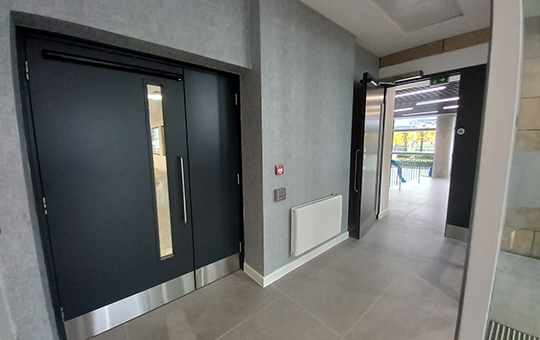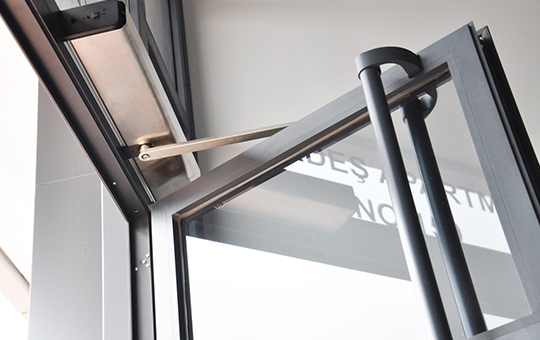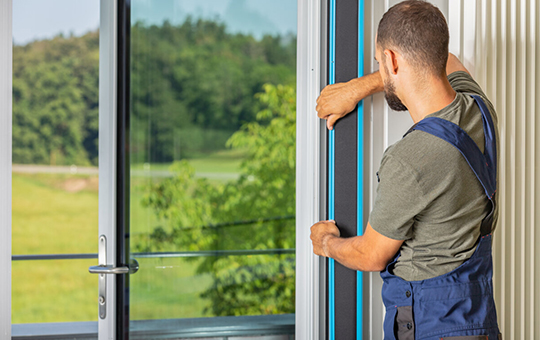Swing Door Safety... Just how safe are swinging doors?
Swinging doors are a common feature in commercial buildings today, but it is vital that they are installed and maintained correctly and that all necessary safety features are employed, especially if the installation is to comply with EN16005.
Tips to improve safety
- Use door stops: These door stops can prevent doors from swinging farther than they should.
- Always use safety glass: Most swinging doors are made of glass, and to ensure the safety of users, tempered or laminated glass should be used.
- Install locks: Where the swinging doors are automatic, this should not be too much of an issue as the sensors and opening mechanism can be switched off. However, if the door is manually operated, it is best to fit locks to deter break-ins or theft.
- Use warning signs: It is vital to ensure that all users are aware that these doors swing, this being especially important on the side of the door that swings towards any traffic. Alerting people to the presence of swing doors is known to reduce the risk of collisions.
- Make sure that the area around the doors is clear: As with any entrance, it is essential to make sure that there are no obstacles around the door opening as these could cause someone to trip or fall and potentially interfere with the door operation.
- Select only the best high-quality doors: There is no doubt that you get what you pay for, and the same is true for swing doors. High-quality doors are less likely to have manufacturing issues or other problems that could pose a risk to safety.
- Maintenance: Regular maintenance is vital to ensure the correct operation of the door mechanism and sensors.



The collision risk
The biggest safety issue that is associated with swing doors is the risk of collision. While the operation of any automatic swing doors are set to make sure that they open in a safe manner, manuals doors can swing open quickly, hitting someone who is standing too close or who is not paying full attention. The dangers here increase when children or individuals with mobility or some vision impairment are involved.
This is why automatic doors are far safer than manual doors, the safety protocols ensuring the safety of all users.
Sensors and safety areas
With an automatic door, sensors are used to detect the approach to the door and trigger the opening and closing mechanism. When they pick up the movement of a pedestrian approaching the door they start to open the door smoothly, it also stopping in a smooth manner, with no sudden impact on the door stop.
The sensor should be set to trigger when the pedestrian is at least 43” from the door and detect anything taller than 27”.
The door should open to 80 degrees, taking at least 1.5 seconds to reach this point.
The door should be set to close in the same safe manner, but only when there is no one in the sensor area, this extending on the opening side and the exit side. Sometimes pressure mats are used as the sensor, and in this instance the mats should be tested to make sure that there are no dead spots, as these could cause the door to close prematurely. There should also be at least a 4 second delay before the door starts to close once any user has left the detection area.

Clear the area
As mentioned above, it is essential to ensure that the opening area is clear of objects and debris. However, it is also vital that no notice boards, literature racks and displays of any sort are situated in the operation zone of the doors as these are likely to encourage loitering.
Finger trapping
Swinging door finger guards are used to protect fingers and hands from getting trapped in the gap between the door and the frame when a swing door is in operation. They are Normally made using a flexible material, like rubber or PVC, and are installed on the hinge side of the door frame.
To stop fingers being trapped, finger guard compresses against the door, which creates a seal that covers the gap between the door and the frame. This stops fingers or other objects from getting caught in the gap and reduces the risk of injury to users.
These finger guards are particularly important in locations where there are children or people with mobility or vision impairment issues, as they may well be less aware of the potential hazards associated with swing doors

There are many types of swinging door finger guards available, these including surface-mounted guards, concealed guards, and wrap-around guards.
In all cases it is up to the owner of the premises to choose the appropriate version of finger guard, one that will ensure the safety of all users.
Swing door safety barriers
In some cases it is possible to approach a swinging door in a manner that could cause the door to open on an approaching user. This is normally only possible when there are multiple doors covering a wide pedestrian area. In these cases, it is possible to approach a door from an angle that could result in the door opening on the approaching user. These barriers stop this type of ‘side approach’ and thus protect the pedestrian. They must be at least 900mm in height and be used on both sides of the door opening.
Please do contact us to discuss which type of automatic doors are best suited for your premises as well as any associated safety measures and equipment.




